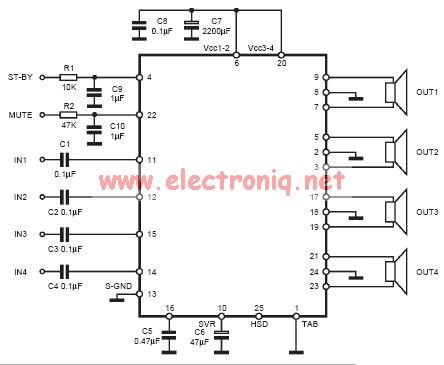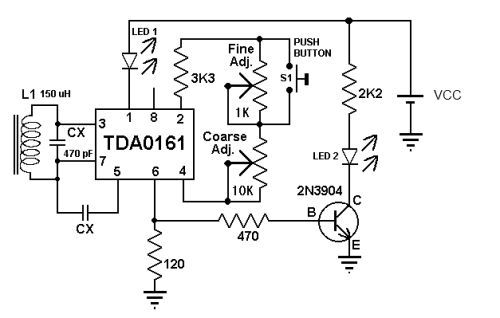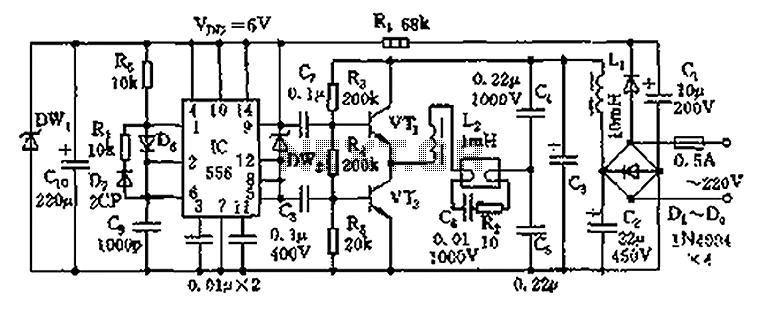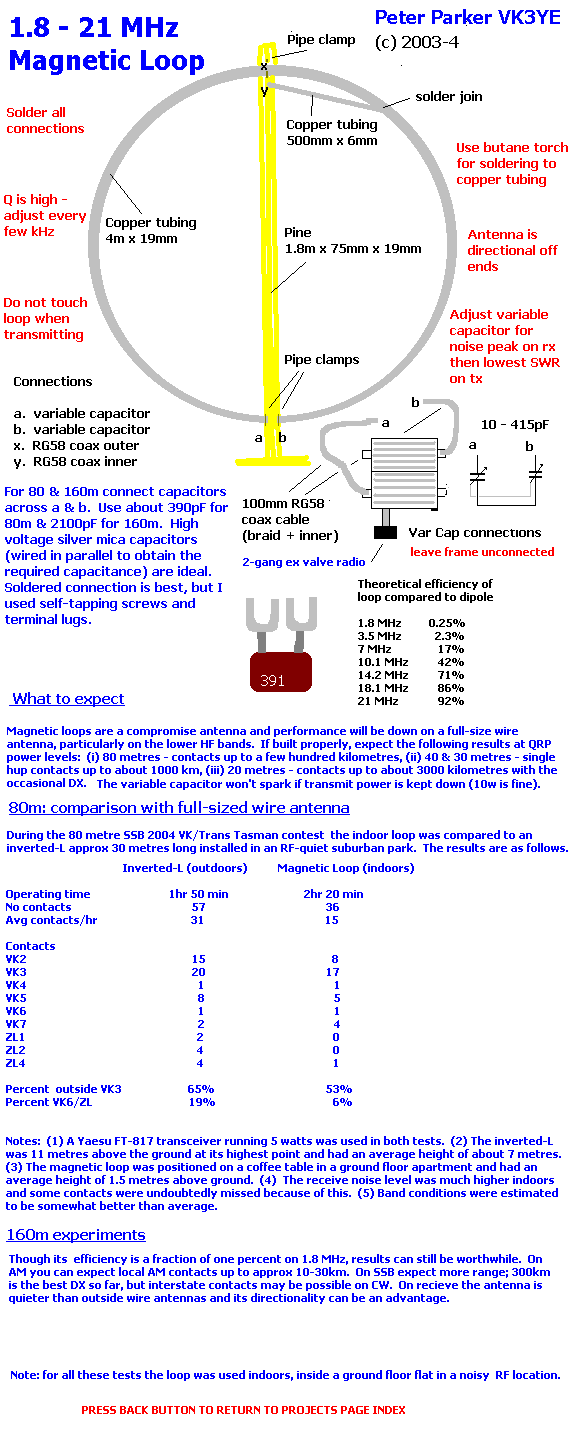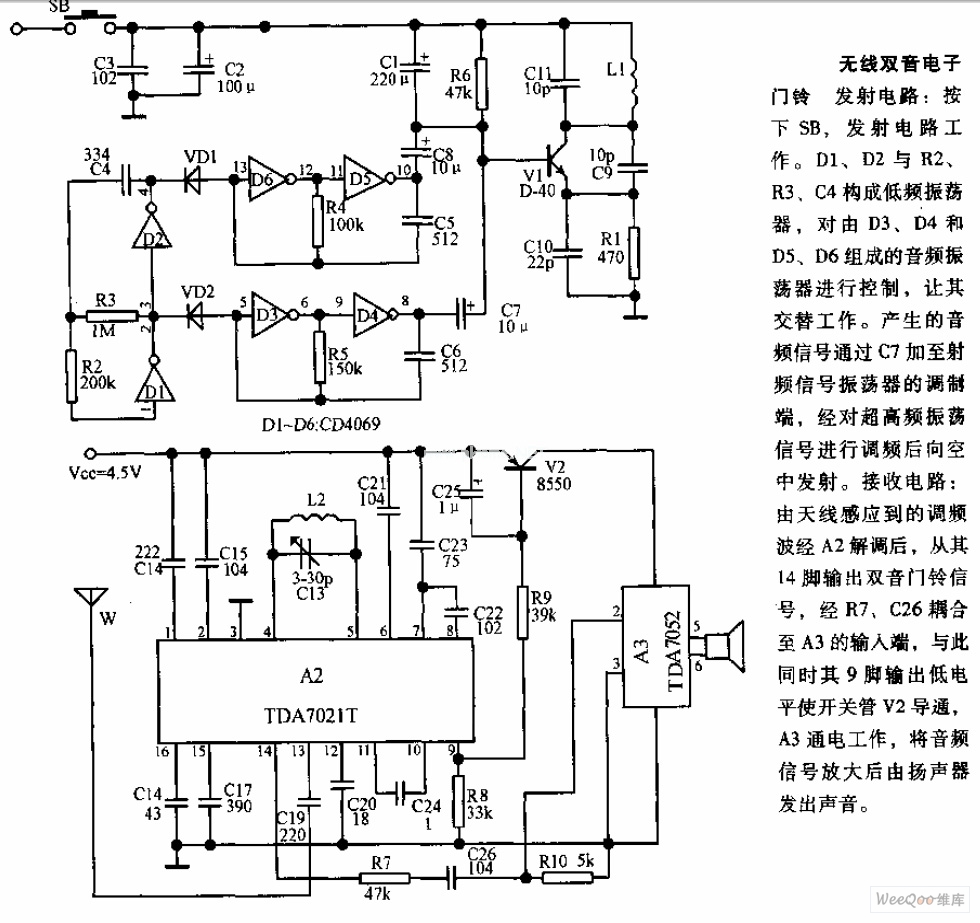
Electronic Bagpipe
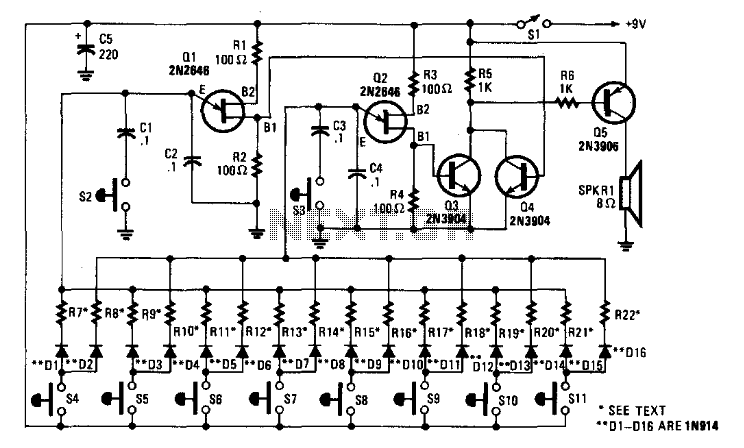
The electronic bagpipe simulates the sound of actual instruments. This circuit employs two UJT oscillators and an amplifier (Q3, Q4, and Q5). Resistors R7 to R22 are chosen to achieve the desired tonal range (typically between 3 to 300). Each key selects resistors for the two oscillator circuits Q1 and Q2. Switches S2 and S3 adjust the tonal range of S4 through S11.
The electronic bagpipe circuit is designed to replicate the acoustic characteristics of traditional bagpipes by utilizing two Unijunction Transistor (UJT) oscillators. The primary function of these oscillators is to generate the fundamental frequencies that mimic the drone and melody of the bagpipe sound. The oscillators, Q1 and Q2, are configured to produce different pitches, which can be controlled by selecting specific resistors from the range of R7 to R22. These resistors are critical for tuning the oscillators to the desired frequencies, enabling a tonal range that typically spans from 3 Hz to 300 Hz.
The amplification stage, comprising transistors Q3, Q4, and Q5, serves to boost the output signal generated by the oscillators to a level suitable for driving speakers or other audio output devices. This amplification is essential to ensure that the sound produced is loud enough for performance or playback.
User interaction with the circuit is facilitated through keys that allow the selection of various resistors, effectively changing the pitch of the oscillators. Each key corresponds to a specific resistor configuration, enabling the musician to play different notes and create a melody. Additionally, switches S2 and S3 are incorporated into the design to provide further tonal adjustments. These switches modify the resistor values connected to the oscillators, allowing for fine-tuning of the sound output and expanding the tonal palette available to the user.
Overall, this electronic bagpipe circuit combines innovative oscillator design and a flexible amplification system to create a versatile instrument that can replicate the rich, complex sounds of traditional bagpipes while providing modern electronic control and adaptability. The electronic bagpipe mimics the sound of real instruments. This circuit uses two UJT oscillators and an amplifier (Q3, Q4, and Q5). R7 through R22 are selected for tonal range desired (typically 3 300 ). Each key selects resistors for the two oscillator circuits Ql and Q2. S2 and S3 vary the tonal range of S4 through Sll. 🔗 External reference
The electronic bagpipe circuit is designed to replicate the acoustic characteristics of traditional bagpipes by utilizing two Unijunction Transistor (UJT) oscillators. The primary function of these oscillators is to generate the fundamental frequencies that mimic the drone and melody of the bagpipe sound. The oscillators, Q1 and Q2, are configured to produce different pitches, which can be controlled by selecting specific resistors from the range of R7 to R22. These resistors are critical for tuning the oscillators to the desired frequencies, enabling a tonal range that typically spans from 3 Hz to 300 Hz.
The amplification stage, comprising transistors Q3, Q4, and Q5, serves to boost the output signal generated by the oscillators to a level suitable for driving speakers or other audio output devices. This amplification is essential to ensure that the sound produced is loud enough for performance or playback.
User interaction with the circuit is facilitated through keys that allow the selection of various resistors, effectively changing the pitch of the oscillators. Each key corresponds to a specific resistor configuration, enabling the musician to play different notes and create a melody. Additionally, switches S2 and S3 are incorporated into the design to provide further tonal adjustments. These switches modify the resistor values connected to the oscillators, allowing for fine-tuning of the sound output and expanding the tonal palette available to the user.
Overall, this electronic bagpipe circuit combines innovative oscillator design and a flexible amplification system to create a versatile instrument that can replicate the rich, complex sounds of traditional bagpipes while providing modern electronic control and adaptability. The electronic bagpipe mimics the sound of real instruments. This circuit uses two UJT oscillators and an amplifier (Q3, Q4, and Q5). R7 through R22 are selected for tonal range desired (typically 3 300 ). Each key selects resistors for the two oscillator circuits Ql and Q2. S2 and S3 vary the tonal range of S4 through Sll. 🔗 External reference
Warning: include(partials/cookie-banner.php): Failed to open stream: Permission denied in /var/www/html/nextgr/view-circuit.php on line 713
Warning: include(): Failed opening 'partials/cookie-banner.php' for inclusion (include_path='.:/usr/share/php') in /var/www/html/nextgr/view-circuit.php on line 713
